Not much more than a half century ago, Missouri's wild turkey population was in danger of disappearing from the landscape. By the early 1950s, it was estimated that fewer than 2,500 turkeys were left in only 14 Missouri counties. Their restoration is one of the state's great conservation success stories.
Missouri is home to the eastern subspecies of wild turkey, one of five subspecies native to North America. Once abundant, turkey numbers declined rapidly during the early 1900s, as they did in much of the eastern United States. Unregulated harvest and habitat destruction caused by extensive deforestation, uncontrolled burning and free-range grazing resulted in the population's near demise in Missouri.
In the early 1950s, intensive habitat management on several Ozark refuges and modification of the cannon net set the stage for a historic wildlife restoration effort. The cannon net allowed biologists to capture flocks of wild turkeys in areas where they were abundant and relocate them to other parts of the state that had adequate habitat.
Initiated in the mid-1950s, Missouri's turkey restoration efforts would span more than two decades and involve the relocation of more than 2,600 turkeys to 213 sites in 91 counties. In less than half a century, Missouri's turkey population went from the brink of extirpation, or localized extinction, to an estimated 300,000 to 400,000 birds, among the largest populations in the nation.
Many private landowners in Missouri are interested in creating and maintaining habitat for wild turkeys. This guide provides recommendations for doing just that. Before learning about specific habitat management practices, it is important to build basic knowledge about turkey biology, population dynamics and habitat needs. This broader information will help landowners and managers better understand the value of implementing specific habitat management practices.
Wild turkey biology and life history
Physical characteristics
Turkeys, the largest game bird in North America, are gallinaceous birds, a group that includes pheasants, quail and grouse. These birds have short beaks and wings, feed and nest on the ground and have young that leave the nest shortly after hatching. Adult males, commonly called gobblers, average 17 to 21 pounds (Figure 1). Female turkeys, or hens, average 8 to 11 pounds (Figure 2). A juvenile male is called a jake; a female is a jenny.
Several physical characteristics help identify male and female turkeys. In addition to being larger than hens, gobblers have a colorful, unfeathered head and neck that are red, white and blue. Males are also darker overall with black-tipped breast feathers and a feather-like appendage, called a beard, protruding from their neck above the breast (Figure 3). Unlike feathers, turkey beards are not molted. They grow throughout a bird's life, although friction from the ground and accumulated snow and ice in winter reduce their length. About 5 percent of hens have beards, but theirs are typically shorter and thinner than those of males. Male turkeys also have a spur on the lower part of each leg, which is much longer than the tiny button-spur that hens have. Hens are also much smaller and more drab-colored than males, with buff-tipped breast feathers. Their heads are predominantly blue with a feather tract that extends up the back of the neck.
Several characteristics help determine a turkey's age. Adult turkeys have symmetrical tail fans, whereas the middle four to six feathers of a juvenile's tail fan are longer than the outside feathers. In adult turkeys, the white barring of the ninth and 10th primary wing feathers extends to the tips (Figure 4a). In juvenile turkeys, the feather tips are more pointed, and the white barring does not extend to the tip of the 10th, and sometimes ninth, primary wing feather (Figure 4b). Beard and spur length also help differentiate adult and juvenile males. Most adult males have beards longer than 6 inches (most are at least 8 inches). During the first spring of a male turkey's life, its beard is typically only 3 to 4 inches long. Though spurs grow continuously like beards, they do not wear down easily. The spurs of juvenile males average about a 1/4 inch long during their first spring. The spurs of adult male turkeys are typically at least 7/8 of an inch long.
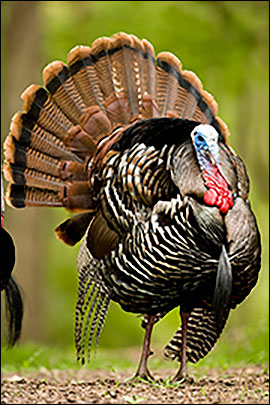 Figure 1
Figure 1
Adult male turkey, called a gobbler.
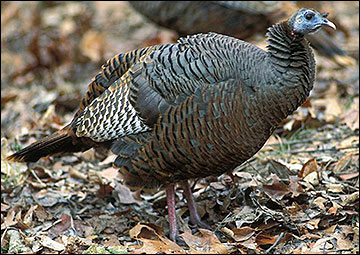 Figure 2
Figure 2
Female turkey, called a hen.
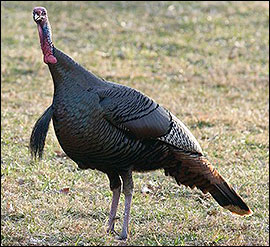 Figure 3
Figure 3
Beards are most commonly found on male turkeys, growing 6 inches or longer.
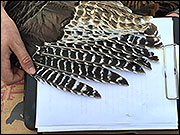
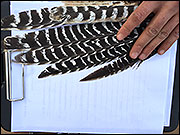
Figure 4a
Examining the last one or two wing feathers is one way to determine age. Adults have rounded feathers with white barring to the tip.
Figure 4b
The wing feathers of juveniles have narrow pointed tips with no barring on the last 2 inches of the last one or two feathers.
Reproduction and nesting ecology
Turkeys spend winter in large flocks to help them find food and avoid predators. As March arrives, these large flocks begin to break up. Gobblers, which have spent the winter together, begin to join flocks of hens. As daylight hours increase gobblers' testosterone levels, their behavior begins to change, intensifying as the breeding season draws nearer.
The first noticeable change in behavior prior to the breeding season is when male turkeys begin to gobble before leaving their tree roosts at daylight. They spend brief periods strutting for hens with their tail fans raised and spread, body feathers erect, and wings dragging along the ground. Male turkeys fight to determine social status and establish dominance. Dominant gobblers will begin to assert their presence to hens even before the winter flocks break up. As winter flocks disband, turkeys often travel 1 to 3 miles to their spring range; juveniles often travel farther. After this dispersal, dominant gobblers will often associate with a harem of hens, whereas younger subordinate males often remain together. As hens become physiologically ready to breed, they signal their receptivity to males. Although turkeys become sexually mature at about 1 year of age, and some jakes do breed, older males breed most of the hens.
A turkey's nest consists of a simple, shallow depression on the ground in dense cover (Figure 5). In Missouri, egg-laying typically begins in early April, and hens usually lay about one egg per day. During this period, hens spend little time at the nest, covering it with leaves when departing. After they lay a typical clutch of 10 to 12 eggs, hens will spend about 22 to 23 hours a day on the nest, incubating, leaving only to eat, drink and defecate. Although hens do not cover the nest during these breaks, the light-colored speckled eggs blend in well with the surrounding leaf litter. Despite the camouflaged eggs and dense cover of nest sites, most nests are lost to predators each year. About 50 percent of adult hens will attempt a second nest if their first attempt is not successful. Juvenile hens are much less likely to renest should their first nest fail.
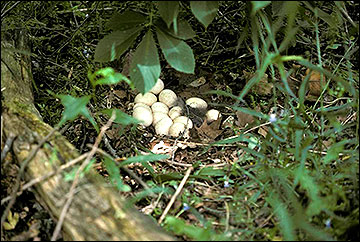 Figure 5
Figure 5
Wild turkey nest.
Brood-rearing season
The incubation period for wild turkeys lasts about 28 days. Within two days from the time they first begin to chip away at the inside of the eggshell, young turkeys, called poults, are following the hen in search of food (Figure 6). In Missouri, most poults hatch in late May and early June. Although poults are very mobile and can feed themselves immediately after hatching, they cannot fly until about 2 weeks of age. During this time, they spend nights on the ground and are quite vulnerable to predators. Once they start roosting off the ground, their chances of survival increase considerably. Later in the summer, it is common for turkeys to combine into larger brood flocks. Hens that did not rear young often form their own small flocks. After breeding season ends, male turkeys form separate flocks.
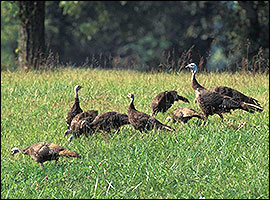 Figure 6
Figure 6
Wild turkey hen with poults.
Fall and winter seasons
The area used by turkey flocks in fall and winter varies in size and depends on the availability of suitable habitat and abundance of food sources. When acorns are plentiful, turkeys do not need to travel far to find food, resulting in smaller home ranges. When acorns are sparse, turkeys expand their range, and their daily movements increase. Hens and their young remain together during the fall and much of winter, often in large flocks. Older males remain in separate flocks, but their ranges often overlap with those of hens. Although turkeys spend most of the fall in forested areas, they also use agricultural fields, especially as winter approaches (Figure 7). Turkey flock size is largest in winter, often with more than 20 turkeys in a single group. By late winter, many juvenile males begin to separate from the brood flocks they've been part of since the previous summer. These young males often form their own small flocks or sometimes join flocks of gobblers.
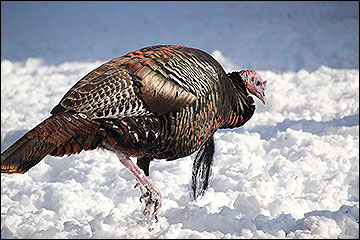 Figure 7
Figure 7
Wild turkey in winter.
Factors that influence population dynamics
Turkey populations are dynamic and fluctuate each year depending on a number of factors. Only about half of the hens survive each year; gobblers' survival is even lower, averaging 40 and 45 percent in Missouri. Biologists say that turkey populations "turn over" about every three years, resulting in a population consisting mostly of new turkeys every few years. Important factors that influence these population fluctuations are:
- Hen survival
- Nest success
- Poult survival
Hen survival can vary considerably from year to year and is usually lowest in the spring. Nesting and rearing young take a lot of energy and also put hens at great risk of predation. In more northern environments, severe winter weather can result in low survival if turkeys do not have ready access to food. In Missouri, winter survival is often higher than during other seasons due to the milder climate. Turkey survival during fall is usually high, but because hens can be harvested during fall hunting seasons, managers carefully regulate the fall harvest to make sure it does not adversely affect the population.
Nest success is one of the most important factors impacting turkey populations and can vary considerably from year to year. Wet weather during nesting season tends to lower success. According to researchers' "wet hen hypothesis," hens that are wet during incubation give off more odor, making it easier for predators to locate them. Hens' physical condition also influences nest success. Hens that are in good condition produce more high quality eggs, resulting in healthier poults. Even in a good year of production, less than half of turkey nests will be successful; most are lost to predation during the egg-laying or incubation periods.
As with hen survival and nest success, poult survival can vary considerably from year to year. Typically, less than half of the turkeys that hatch will survive their first two weeks. Like nest success, poult survival is also influenced by weather. Earlier in the brood-rearing period, cold, wet weather reduces poult survival. Young poults cannot regulate their body heat well and depend on the hen for warmth. If they get wet and cold, poults can succumb to hypothermia. However, summers that are excessively dry can reduce the availability of insects, the poults' primary food source. A moderate amount of precipitation in summer is likely best for poult survival.
Habitat
Habitat quantity and quality also influence nest success and hen and poult survival. Healthy animals are most likely to survive; so having habitats that allow turkeys to meet their needs is critical to the population's well-being. Nest success tends to be higher when greater amounts of cover are available. To rear their broods successfully, hen turkeys must have access to the right combination of food and cover. Better habitat equates to higher poult survival. Influencing these habitat factors directly impacts turkey population dynamics and is the most effective way for landowners to increase turkey numbers on their property.
Predators
Predator populations also influence the dynamics of turkey populations. Turkeys have been trying to evade predators for as long as they've existed. Many of their characteristics are adaptations to avoid predators. For example, hen turkeys are cryptically colored, reproduce at a young age, lay large clutches and can renest. As Missouri's landscape has changed over time, some turkey predator populations have increased. Creating and maintaining quality habitat for turkeys is, therefore, especially important. However, the high variability of Missouri's turkey hatch each year suggests that predators are not the main factor influencing nest success. Despite the abundance of predators, turkeys will be able to thrive in Missouri as long as sufficient habitat exists. Table 1 lists some turkey predators in Missouri.
Table 1
Animals that prey on wild turkeys and their nests.
| Predator | Preys on | ||
|---|---|---|---|
| Nests | Poults | Juveniles and adults | |
| Striped skunk | X | ||
| Black rat snake | X | ||
| Coyote | X | X | X |
| Bobcat | X | X | X |
| Raccoon | X | ||
| Gray fox | X | X | X |
| Red fox | X | X | X |
| Great horned owl | X | X | |
| Opossum | X | ||
| Red-tailed hawk | X | ||
| Feral hog | X | ||
Diseases
Although there are many diseases that can affect wild turkeys, few cause widespread population declines. The most commonly reported disease in turkey populations is avian pox, a viral disease also found in other bird species. Avian pox causes wart-like lesions on the unfeathered portions of a bird's body. The virus is transmitted by mosquitoes and biting flies and also through ingestion of virus-induced lesions shed by infected birds. Although the disease can cause death, the lesions often disappear within two to three months, and the infected bird no longer remains a carrier of the virus. If the infection rate is high enough, avian pox can cause localized declines in turkey numbers but is unlikely to have any large-scale impact.
Lymphoproliferative disease virus is also common in wild turkey populations, but the disease caused by the virus is rare. Most infected turkeys appear perfectly healthy and suffer no adverse effects. Should the disease develop, it causes lesions in the bird's internal organs, as well as external lesions similar to those caused by the avian pox virus. There is still much to learn about this virus only recently discovered in wild turkey populations, but evidence suggests that it is not likely to have population-level effects.
Histomoniasis, commonly referred to as "blackhead," is another disease that can affect turkeys and other birds. Caused by a parasitic infection, histomoniasis is reported infrequently in wild turkey populations. Although the disease usually results in the death of infected turkeys, large-scale population declines from the disease are rare.
Missouri Department of Conservation biologists keep records of wild turkey disease reports and submit carcasses for necropsy to determine causes of death. Private citizens can help prevent the introduction or spread of disease to wild turkey populations by not releasing pen-raised turkeys into the wild. Pen-raised turkeys can carry parasites and infectious diseases that can pose considerable threat to wild turkey populations. Plus, doing so is illegal in Missouri.
Wild turkey habitat requirements
Turkeys are found throughout Missouri's diverse landscape, evidence that they easily adapt to many land cover types. Populations exist in all 114 counties, from those with less than 10 percent forest cover to those that are nearly all forested. Turkeys use grasslands, woodlands, cropland and other areas that provide suitable conditions for their survival. Known as opportunistic omnivores, they eat a wide variety of food. Their diet, which includes grasses and forbs (flowering plants), hard and soft mast (nuts, seeds, and fruits) and insects, changes seasonally and contributes to their adaptability.
Turkeys generally do best in landscapes that are about half forested and half open. Forested areas provide escape cover, places to roost and loaf, and food in the form of soft and hard mast. Openings provide areas for courtship display, nesting and brood-rearing cover, grasses and forbs for adult food and insects for poults.
Spring and summer seasons
Spring and summer encompass nesting and brood-rearing seasons. During the breeding season, turkeys often use open areas. Green grasses and forbs, important foods at this time of year, can be readily found in these areas. As hens feed in openings like pastures and cropland, it is common to see gobblers strutting alongside them. Openings also provide insects, eaten by hens for the protein and calcium needed for egg production. Turkeys eat grasshoppers, beetles, ants and spiders, among other invertebrates. In spring, they commonly eat crabgrass, panic grass, paspalums, wood sorrel and desmodium.
Turkeys nest in habitats with a dense understory about 2 to 3 feet tall, typically made up of grasses, forbs and shrubs. The particular species of vegetation is not as important as its structure. With suitable ground cover, turkeys will nest in open and forested areas: old fields, thinned forests, forest openings and rights of way are all readily used (Figures 8a and 8b). Dense ground cover provides auditory, olfactory and visual protection from predators. Preferred nesting sites are along an edge between two land cover types, such as where an opening meets forested cover. Hens often nest close to a water source, such as a stream or small pond. During incubation, hens greatly reduce their intake of food, which contains considerable moisture, so having a water source near the nest is important.
After a brood hatches, a hen turkey takes its poults to a brood-rearing habitat (Figure 9a). These areas, typically made up of knee-high grasses and forbs, are most often in openings such as pastures, hayfields, old fields, rights of way and food plots. Open areas provide superior brood habitat because they have more insects than forested areas. Savannas and woodlands also serve as great brood-rearing habitats (Figure 9b).
Good brood-rearing habitats have several characteristics: They must have an abundance of insects, be tall enough to provide cover for poults and low enough to allow good visibility for the hen. They should also be near cover where broods can loaf when not foraging. The density and species composition of brood-rearing habitats are also important. Native vegetation is much better than exotic cool-season grasses because it is not as dense. Poults can move freely through the cover because there is plenty of bare ground intermixed with vegetation.
While poults feed heavily on insects their first summer, hens and older males mainly eat plant matter, as they do throughout the year. After their first month, poults start eating a diet that is more like that of an adult. In summer, the seed heads of grasses, especially crabgrass, are a favorite food of adult turkeys, as is soft mast. Turkeys prefer blackberries, wild grapes and plums, typically found in openings and along their edges.
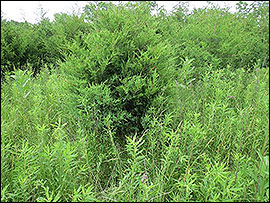 Figure 8a
Figure 8a
Wild turkey nesting habitat.
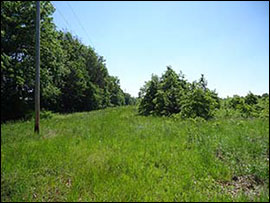 Figure 8b
Figure 8b
A right of way and old field along wooded edge can serve as wild turkey nesting habitat.
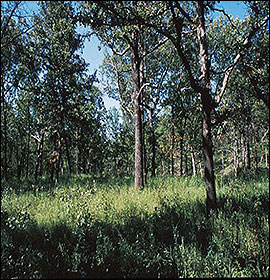 Figure 9a
Figure 9a
Woodland wild turkey brood cover.
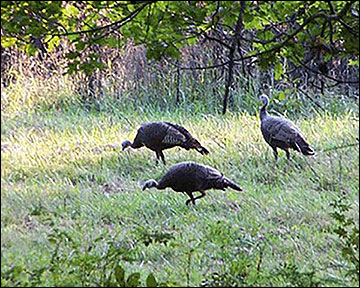 Figure 9b
Figure 9b
Wild turkeys use openings in woodland habitat.
Fall and winter seasons
As summer transitions to fall, turkeys shift their range to take advantage of seasonally available foods like acorns. Juveniles continue to grow rapidly, and adults are developing fat reserves to sustain them through winter. Acorns from black, blackjack, red, post, scarlet, white and pin oaks are an important food that turkeys start eating as soon as they drop. During fall, turkeys also eat a variety of soft mast, including persimmon, sumac, viburnam, hawthorn and flowering dogwood. Although turkeys usually spend most of the fall in forested areas, they will also use agricultural fields, especially during years when mast is sparse.
During winter, food and roosting cover are especially critical. As long as acorns are available, turkeys will spend considerable time in mature forests. In the more agricultural areas of the state, it is common to see turkeys feeding on waste grain in harvested corn and soybean fields. If suitable roosting cover is close to a food source, turkeys travel very little during winter, conserving energy. Turkeys often roost on the upper slopes in hardwood forests, staying out of ridge-top winds while avoiding the cold air that pools near the lower slopes.
Habitat management for wild turkeys
With knowledge of the types of habitat that turkeys need, private landowners can implement management practices that benefit the turkey population on their property. Start by assessing the property's current habitat conditions and identifying, and then planning to address, any limiting factors that may exist.
Evaluate existing conditions and develop a plan
Turkey habitat is often a byproduct of land use, whether forest or agricultural production. Habitat management practices — such as timber harvesting, timber stand improvement, prescribed fire, discing or managing a forest or woodland for improved mast production — can enhance food and cover. A habitat evaluation can help landowners determine a property's strengths and weaknesses related to the seasonal needs of turkeys. Limiting factors will become apparent and guide management practices to increase your property's value to turkeys. This information will be useful when developing a habitat management plan for your property.
To evaluate your property, you will need an aerial photograph, which can be obtained from these sources (see Resources section):
- MU Center for Applied Research and Environmental Systems
- Missouri Department of Natural Resources GIS Mapping Service
You can use the photographs to determine the acreage and distribution of each habitat or land cover type (e.g., cedars, hardwoods, cropland, grasslands and pastures). When assessing the limiting factors for turkeys, remember to consider adjacent properties and the resources that they contain. The annual home range of a turkey can exceed 3,000 acres; so the same turkeys that use your property are most likely using neighboring land as well. By meeting the needs of turkeys throughout the year, you have a greater chance of keeping them on your property for a longer period of time. Because turkeys and white-tailed deer have similar food and cover type preferences, you can also use the information in MU Extension publication G9492, Enhancing White-tailed Deer Habitats on Your Property: Evaluating Habitat, as a resource for evaluating your property for turkeys.
Developing a habitat map of your property
Aerial photographs will help you evaluate your property and develop a habitat map and management plan. You will learn to recognize various habitat types from an aerial photograph by comparing familiar habitats with those that appear similar on the photograph. Photographs can help with the following:
- Delineating property boundaries
- Delineating roads, power lines and trails
- Identifying openings, such as pastures, old fields, croplands, timber regeneration sites, logging decks, etc.
- Identifying drainages, water sources and buildings
- Identifying types of forest, such as cedar and hardwood stands
- Managing woodlands and forests for turkeys
Areas on your property with trees can be classified as forest or woodland. Woodlands have 30 to 80 percent canopy closure, a sparse midstory and an understory of forbs and grasses. They most often occur on west and south facing slopes and support a mixture of fire-tolerant tree species. In contrast, forests typically occur on north and east facing slopes, have a more closed tree canopy, consist of multiple layers of tree species and have shade-adapted shrubs and saplings in the mid- and understories. Forests also contain more fire-sensitive shrubs and hardwood trees.
There are two groups of oaks — white and red. In Missouri, the white oak group contains species such as white, swamp white, post, bur and chinkapin. The red oak group contains species such as northern red, black, blackjack, Shumard, pin and shingle. Wildlife prefer acorns from the white oak group because they have less tannin. White oak acorns mature in one growing season, whereas red oak acorns take two years. Management activities that promote red and white oaks benefit turkeys and other wildlife species.
Most oak species begin to bear acorns between 20 to 25 years of age, with the best mast-producing years from age 50 to 100 years when the trees are 14 to 24 inches in diameter. Since many wildlife species, including turkeys, use acorns as a primary food source, it is important to have mast-producing oak trees on the forested parts of your property (Figure 10). Hickories should also be present, too, because these mast-producing trees can relieve some of the pressure put on the acorn crop by squirrels and white-tailed deer. To ensure enough acorns for turkeys, maintain 40 to 60 percent of the timbered portion of your property in oak-hickory forests at least 50 years old.
Many forests and woodlands in Missouri are over-stocked, meaning they contain too many trees. Timber stand improvement (TSI) can benefit turkeys while also improving the health of the forest by removing stunted, thin-crowned, poorly-formed, low vigor and damaged trees — with the exception of den trees that provide shelter for other wildlife. Poor mast producers also should be removed, because they use as much water and soil nutrients as good mast producers. During TSI, the best mast-producing trees should be protected as sources of seed stock. Overstocked forests often have little vegetation on the forest floor. After trees are removed, sunlight hits the ground, resulting in the growth of vegetation that provides food and cover for turkeys (Figures 11a and 11b).
In forests used for commercial timber production, several harvesting methods promote regeneration of oak species, such as clearcutting, shelterwood harvesting, and group selection cuts. Using these methods ensures that oak species will remain an important part of the landscape, benefiting turkeys and other wildlife species in the future. Following a harvest, it is important to conduct TSI when the young stand is about 20 to 35 years of age. This effort promotes full crown development of the remaining trees and vegetative growth in the understory.
For more information about managing your woodlands and forests for turkeys, refer to MU Extension publication G9415, Integrating Woodland and Wildlife Management Practices on Your Property. MU Extension publication G9414, Managing Oaks for Acorn Production to Benefit Wildlife in Missouri, provides more information about managing oaks in your woodlands and forests.
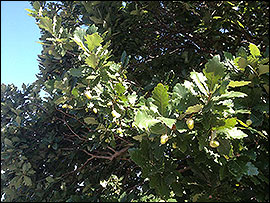 Figure 10
Figure 10
Acorns, like these produced by swamp white oaks, are a food source for wild turkeys during the fall and winter.
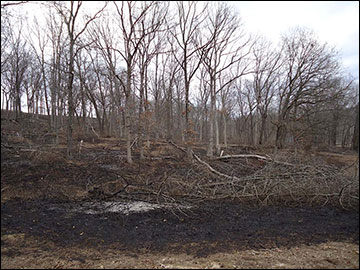 Figure 11a
Figure 11a
Prescribed burn as part of timber stand improvement (TSI). A flush of plants will quickly germinate after this and provide food, nesting and brood-rearing cover for several years.
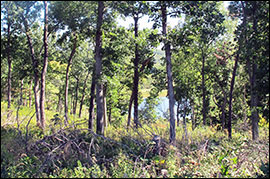 Figure 11b
Figure 11b
Vegetation growth after a recently conducted TSI.
Managing grasslands, old fields and other openings for turkeys
Although turkeys will use openings of various sizes, they prefer those ranging from 5 to 20 acres. These areas provide resources within reasonable distance from escape cover. To benefit turkeys, at least 10 percent of an overall acreage should be maintained as open land; a property made up of about 50 percent of well-distributed openings is ideal. Openings include pastures, hayfields, cropland, orchards, roadsides, rights of way, new regeneration areas, old fields and food plots (Figure 12).
Depending on vegetative height, density and species composition, openings can provide turkeys with places to feed, strut, nest and rear their broods. Except for the concealment cover needed for nesting, turkeys do not often travel through vegetation that is taller than they are because it hinders their ability to see predators.
Turkeys typically nest in openings or along edges containing grasses, forbs and shrubs that are 2 to 3 feet tall — taller than the habitats in which they strut, feed and rear their young. Old fields, with their mix of woody and non-woody cover, are one of the best turkey nesting habitats. Openings with a variety of grasses and forbs serve as good feeding sites, as does cropland, particularly during fall and winter.
Openings provide the best turkey brood-rearing habitats because, if managed properly, they provide an ideal combination of food and cover. The most important characteristics of brood-rearing habitat are height, density and species composition. Vegetation that is 1 to 2 feet tall is ideal cover for poults but short enough to give the hen an unobstructed view of approaching predators. Ideally, brood-rearing habitat provides about 60 to 80 percent ground cover. Native vegetation provides better brood-rearing habitat than denser exotic species. Its stands contain bare ground, allowing poults to travel freely and feed efficiently.
Herbicides, prescribed fire, discing, timber harvests and establishment of food plots are practices used to create and maintain openings. Cool season pastures, such as tall fescue, provide little turkey habitat and should be converted to native vegetation. Burn or hay fescue fields during August or early September to remove most of the vegetation. After the fescue grows back to about 6 inches tall, spray the field with 2 quarts per acre of glyphosate. The seedbank will often contain enough seeds to establish native grasses and forbs. If native species must be planted, this is a good combination to use per acre:
- 3 pounds little bluestem
- 1 pounds sideoats grama
- 0.5 pounds Indian grass
- 1 pounds forbs
Once established, openings should be burned on a 2- to 4-year rotation during the dormant season. To increase forb abundance, fields can be strip disced from late October to early March on a 3-year rotation. Although not as beneficial, openings also can be mowed during late winter. It is better to manage different openings in alternate years, rather than treating them all the same year. For more information about managing native warm-season grasses, forbs and other early successional habitats, refer to MU Extension publication G9494, Enhancing White-Tailed Deer Habitats on Your Property: Early Successional Vegetation.
If converting cool season grasses is not possible, these areas can be enhanced by over-seeding with ladino clover, red clover, alfalfa or annual lespedeza at recommended seeding rates. Although not nearly as beneficial as converting the field to native vegetation, over-seeding will enhance plant diversity and add value to the area by providing food for turkeys. Refer to MU Extension publication G4652, Seeding Rates, Dates and Depths for Common Missouri Forages, for more information.
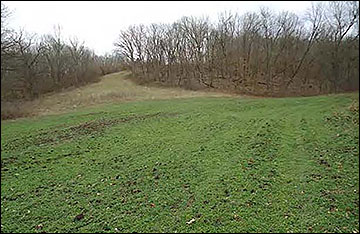 Figure 12
Figure 12
Woodland opening being managed as a supplemental food plot seeded with winter wheat.
Planting and maintaining food plots for turkeys
Although not a substitute for native habitat, supplemental food plots can be established in areas where food sources are limited (Figures 13a and 13b). Turkeys will use food plots throughout the year, although seasonal use of these areas depends on which crop is planted. Food plots planted near preferred cover receive the greatest use. In winter, this includes favorable roost sites. Planting food plots near old field habitats is a good choice, as well. The crops serve as a food source, while some areas in the field can be left fallow to create brood-rearing habitat.
Clover is a good choice for food plots, often used by turkeys in late winter and early spring. During early- to mid-summer, they also provide brood-rearing habitat because they attract insects. Ladino clover is a popular choice. This perennial tolerates poor drainage and is best suited for fertile clay and silt loam soils. Red clover is widely adapted to different soil, climate and moisture conditions. Although classified as a biennial, this plant can persist for 3 or more years with proper management. Crimson clover, an annual plant, can reseed and persist for several years, too. Like red clover, it is adapted to a range of soil types, but prefers well-drained sandy, loamy soils. Crimson clover is not as tolerant of extreme drought, heat or cold as other clovers. Stands of perennial clovers can persist for several years with proper liming, soil fertility and maintenance. Turkeys are highly attracted to each of these clovers, so your choice depends on site conditions and your desired level of maintenance.
Winter wheat, a green food source for wild turkeys from fall through early spring, is another good food plot choice. After the wheat goes to seed, turkeys will feed on the seed heads through summer. If the wheat is left fallow, forbs will germinate in the plot, which will become great habitat for turkey broods. Planting winter wheat with clover makes a great combination. The wheat will act as a nurse crop, helping to establish the clover. These areas — often referred to as "green-browse" plots — benefit white-tailed deer and other wildlife species, as well.
Grain crops like corn, soybeans and grain sorghum can provide an excellent fall and winter food source for turkeys, especially during years of mast failure. Grain crop plots planted for turkeys can be up to 10 acres but should be no smaller than one acre because deer, squirrels, raccoons and other wildlife also use these plots. Plant grain crops in the standard manner or in strips 3 to 4 feet wide, leaving about 2 feet between rows to allow easy traveling for turkeys. Bobwhite quail, mourning doves and other birds will also use these areas. Ideally, these plots would not be harvested to provide the maximum amount of food for wildlife. If these crops must be harvested, consider leaving several unharvested rows along the field border or woodland edge. If left fallow, these areas also can serve as brood-rearing areas the next year.
For more information about establishing and maintaining food plots and planting methods, refer to MU Extension publication G9493, Enhancing White-tailed Deer Habitats on Your Property: Food Plots.
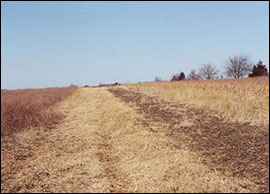 Figure 13a
Figure 13a
Crop field and food plot.
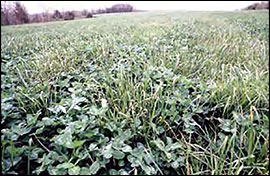 Figure 13b
Figure 13b
A food plot with clover and wheat.
Summary
Turkeys are an important wildlife resource in Missouri, and thanks to conservation efforts they are abundant across the state. Because habitat quality directly impacts the wild turkey population, private landowners' management decisions are key to ensuring that turkeys continue to thrive. Whether you own or manage a small acreage or several hundred acres, you can enhance habitats to provide food and cover for turkeys.
Turkeys use many land cover types, but do best with about a 50:50 ratio of quality forested and open habitats. Turkeys feed on grasses and forbs, soft and hard mast and insects. They use forests most often during fall and winter when acorns are available. Turkeys use open areas during spring and summer for courtship display, feeding, nesting and brood-rearing. Turkeys nest in areas with ground cover that is about 2 to 3 feet tall, including old fields, thinned forests, forest openings and rights of way. Turkeys rear their broods in similar habitats, but where vegetation is shorter (1 to 2 feet tall) and less dense (60 to 80 percent ground cover).
You can map and assess current habitat conditions on your property using aerial photographs. Addressing limiting factors will provide the greatest return on investment. Private landowners should maintain about half of the timbered portion of their property in diverse oak-hickory forests that are at least 50 years old. Thinning forested areas is a great way to improve their suitability for turkeys.
To improve open areas for turkeys, convert exotic cool season grasses to native grasses and forbs. Use herbicides, followed by rotational prescribed fire and discing to maintain these areas. Although not a substitute for native vegetation, food plots offer important resources for turkeys throughout the year. Both clover and winter wheat provide food and can serve as brood-rearing habitat. Grain crops — such as corn, soybeans and grain sorghum — can provide an excellent fall and winter food source and brood habitat if left fallow.
For more information and technical assistance, contact the Missouri Department of Conservation 573-751-4115; www.mdc.mo.gov) and ask to speak with your county's private land conservationist. You can also contact MU Extension Center (www.extension.missouri.edu) for information about enhancing habitats for turkeys and other wildlife species.
Resources
- Missouri Department of Conservation
- Missouri Department of Natural Resources
- National Wild Turkey Federation
- University of Missouri Center for Applied Research and Environmental Systems (CARES)
Photo credits
Jackson Martini, Julia Smith, Missouri Department of Conservation, Robert Pierce